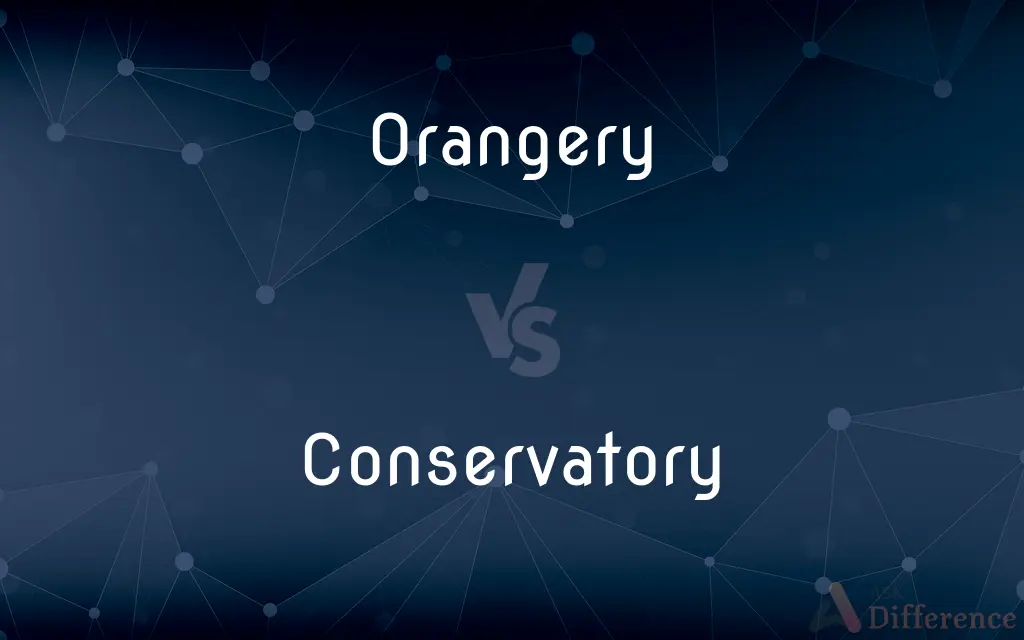Orangery vs. Conservatory — What's the Difference?
By Fiza Rafique & Maham Liaqat — Published on March 4, 2024
An orangery is a brick or stone structure with large windows and a glass roof designed for citrus trees, while a conservatory is a glass structure attached to a house for growing plants.

Difference Between Orangery and Conservatory
Table of Contents
ADVERTISEMENT
Key Differences
Orangeries originated in the 17th to 19th centuries, designed primarily for growing citrus trees during the cold months. They are characterized by solid walls, often made of brick or stone, with large windows and a lantern-style glass roof to provide light and warmth.
Conservatories, on the other hand, are entirely or mostly made of glass, including the walls and roof, creating an environment suitable for a wide variety of plants. While orangeries were a symbol of wealth and status, conservatories have become popular extensions of living spaces, blending the outdoors with the indoors.
Orangeries provide a more insulated environment due to their solid construction, making them ideal for use throughout the year as they can retain heat better than conservatories. Conservatories offer more sunlight exposure due to their extensive glass panels, perfect for plants that require lots of light but might need additional heating in colder climates.
The architectural design of orangeries integrates more with traditional building styles, often featuring decorative elements that match the main house. Conservatories, with their modern glass structure, offer a contemporary look and are designed to maximize views of the surrounding landscape.
In terms of usage, orangeries have evolved from their original purpose and are now used as additional living spaces, dining areas, or kitchens, benefiting from the natural light they provide. Conservatories remain popular for indoor gardening and as sunrooms, offering a seamless transition between the home and garden.
ADVERTISEMENT
Choosing between an orangery and a conservatory depends on the intended use, desired architectural style, and the need for thermal insulation versus maximum sunlight exposure.
Comparison Chart
Structure
Brick or stone walls with large windows and a glass roof.
Mostly or entirely made of glass, including walls and roof.
Origin
17th to 19th centuries for growing citrus trees.
Originally used for growing plants, now popular for additional living space.
Insulation
Better insulation due to solid construction.
Less insulation, might require heating in colder climates.
Sunlight Exposure
Large windows and glass roof provide light, but less than conservatories.
Extensive glass panels offer maximum sunlight exposure.
Architectural Style
Traditional, often matches the main house.
Modern, designed to maximize views.
Usage
Evolved for use as living spaces, dining areas, or kitchens.
Popular for indoor gardening, sunrooms, and blending indoors with outdoors.
Symbol
Historically a symbol of wealth and status.
Contemporary extension of living space.
Compare with Definitions
Orangery
Integrates with traditional architectural styles.
The brick-built orangery seamlessly matches the Victorian style of the main house.
Conservatory
A glass structure attached to a house for growing plants.
The conservatory is filled with tropical plants and offers panoramic garden views.
Orangery
Evolved from citrus tree cultivation to versatile living spaces.
They converted their orangery into a bright, sunlit kitchen.
Conservatory
Requires heating in colder climates due to less insulation.
They installed underfloor heating in their conservatory for the winter months.
Orangery
A traditional structure with solid walls and a glass roof for growing citrus trees.
The estate's orangery housed a collection of exotic orange trees.
Conservatory
Contemporary living space extension.
The family added a conservatory to increase their living space and enjoy the garden year-round.
Orangery
Offers better insulation, making it suitable for year-round use.
Their orangery serves as a cozy dining area during winter.
Conservatory
Features a modern design to maximize sunlight and views.
The modern conservatory has floor-to-ceiling glass panels for an unobstructed view of the mountains.
Orangery
Historically a status symbol among the wealthy.
In the 18th century, having an orangery was a sign of opulence.
Conservatory
Popular as sunrooms and for blending indoor and outdoor spaces.
Their conservatory serves as a tranquil retreat, connecting the home with the natural surroundings.
Orangery
A sheltered place, especially a greenhouse, used for growing orange trees and other delicate plants in cool climates.
Conservatory
A greenhouse, especially one in which plants are arranged aesthetically for display, as at a botanical garden.
Orangery
A greenhouse in which orange trees are grown.
Conservatory
A large greenhouse or hothouse for the display of plants
Orangery
A garden or plantation where orange trees are grown.
Conservatory
A glass-walled and -roofed room in a house
Orangery
A place for raising oranges; a plantation of orange trees.
Conservatory
A place for preserving anything from loss, decay, waste, or injury; particulary, a greenhouse for preserving exotic or tender plants.
Conservatory
A greenhouse in which plants are arranged in a pleasing manner
Common Curiosities
How do orangeries integrate with existing architecture?
Orangeries often feature design elements that match the main house, integrating more seamlessly with traditional architectural styles.
What are modern uses for orangeries?
Modern orangeries are used as additional living spaces, such as family rooms, dining areas, or kitchens, benefiting from the natural light they provide.
Can conservatories be used all year round?
Yes, but they might require additional heating in colder climates due to their glass construction and less insulation.
Why were orangeries originally built?
Orangeries were built to protect citrus trees from cold weather while providing them with enough sunlight and warmth to thrive.
Are conservatories more expensive than orangeries?
The cost varies depending on design complexity and materials, but orangeries can be more expensive due to their solid construction and architectural details.
What makes a conservatory contemporary?
Its extensive use of glass, including walls and roof, offers a modern look and maximizes natural light and views of the surroundings.
What is the main difference between an orangery and a conservatory?
The main difference lies in their construction; orangeries have solid walls with a glass roof, while conservatories are mostly or entirely made of glass.
Can an orangery add value to my home?
Yes, both orangeries and conservatories can add significant value to a home by increasing living space and enhancing aesthetic appeal.
Can I grow plants in an orangery?
Yes, while originally designed for citrus trees, modern orangeries can accommodate a variety of plants, benefiting from their insulated environment.
How do I choose between an orangery and a conservatory?
Consider the intended use, architectural style of your home, and whether you prioritize insulation and traditional design (orangery) or maximum sunlight exposure and modern aesthetics (conservatory).
Share Your Discovery

Previous Comparison
Tonic Receptors vs. Phasic Receptors
Next Comparison
Molar Absorptivity vs. Specific AbsorbanceAuthor Spotlight
Written by
Fiza RafiqueFiza Rafique is a skilled content writer at AskDifference.com, where she meticulously refines and enhances written pieces. Drawing from her vast editorial expertise, Fiza ensures clarity, accuracy, and precision in every article. Passionate about language, she continually seeks to elevate the quality of content for readers worldwide.
Co-written by
Maham Liaqat















































